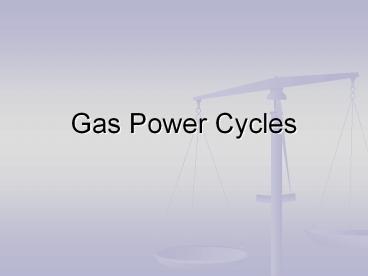Gas Power Cycles - PowerPoint PPT Presentation
1 / 82
Title:
Gas Power Cycles
Description:
Gas Power Cycles Power Cycles Ideal ... Spark-ignition engines Diesel engines Gas turbines Air-Standard Assumptions Air is the working fluid, circulated in a closed ... – PowerPoint PPT presentation
Number of Views:291
Avg rating:3.0/5.0
Title: Gas Power Cycles
1
Gas Power Cycles
2
Power Cycles
- Ideal Cycles, Internal Combustion
- Otto cycle, spark ignition
- Diesel cycle, compression ignition
- Sterling Ericsson cycles
- Brayton cycles
- Jet-propulsion cycle
- Ideal Cycles, External Combustion
- Rankine cycle
3
Modeling
4
Ideal Cycles
- Idealizations Simplifications
- Cycle does not involve any friction
- All expansion and compression processes are
quasi-equilibrium processes - Pipes connecting components have no heat loss
- Neglecting changes in kinetic and potential
energy (except in nozzles diffusers)
5
Carnot Cycle
6
Carnot Cycle
7
Gas Power Cycles
- Working fluid remains a gas for the entire cycle
- Examples
- Spark-ignition engines
- Diesel engines
- Gas turbines
8
Air-Standard Assumptions
- Air is the working fluid, circulated in a closed
loop, is an ideal gas - All cycles, processes are internally reversible
- Combustion process replaced by heat-addition from
external source - Exhaust is replaced by heat rejection process
which restores working fluid to initial state
9
Cold-Air-Standard Assumption
- Air has constant specific heats, values are for
room temperature (25C or 77F)
10
Engine Terms
- Top dead center
- Bottom dead center
- Bore
- Stroke
11
Engine Terms
- Clearance volume
- Displacement volume
- Compression ratio
12
Engine Terms
- Mean effective pressure (MEP)
13
Otto Cycle
- Processes of Otto Cycle
- Isentropic compression
- Constant-volume heat addition
- Isentropic expansion
- Constant-volume heat rejection
14
Otto Cycle
15
Otto Cycle
- Ideal Otto Cycle
- Four internally reversible processes
- 1-2 Isentropic compression
- 2-3 Constant-volume heat addition
- 3-4 Isentropic expansion
- 4-1 Constant-volume heat rejection
16
Otto Cycle
- Closed system, pe, ke 0
- Energy balance (cold air std)
17
Otto Cycle
- Thermal efficiency of ideal Otto cycle
- Since V2 V3 and V4 V1
- Where r is compression ratio
- k is ratio of specific heats
18
Otto Cycle
19
(No Transcript)
20
(No Transcript)
21
(No Transcript)
22
(No Transcript)
23
(No Transcript)
24
Spark or Compression Ignition
- Spark (Otto), air-fuel mixture compressed
(constant-volume heat addition) - Compression (Diesel), air compressed, then fuel
added (constant-pressure heat addition)
25
Diesel Cycle
26
Diesel Cycle
- Processes of Diesel cycle
- Isentropic compression
- Constant-pressure heat addition
- Isentropic expansion
- Constant-volume heat rejection
27
Diesel Cycle
- For ideal diesel cycle
- With cold air assumptions
28
Diesel Cycle
- Cut off ratio rc
- Efficiency becomes
29
(No Transcript)
30
(No Transcript)
31
(No Transcript)
32
(No Transcript)
33
(No Transcript)
34
Brayton Cycle
- Gas turbine cycle
- Open vs closed system model
35
Brayton Cycle
- Four internally reversible processes
- 1-2 Isentropic Compression (compressor)
- 2-3 Constant-pressure heat addition
- 3-4 Isentropic expansion (turbine)
- 4-1 Constant-pressure heat rejection
36
Brayton Cycle
- Analyze as steady-flow process
- So
- With cold-air-standard assumptions
37
Brayton Cycle
- Since processes 1-2 and 3-4 are isentropic, P2
P3 and P4 P1 - where
38
Brayton Cycle
39
Brayton Cycle
- Back work ratio
- Improvements in gas turbines
- Combustion temp
- Machinery component efficiencies
- Adding modifications to basic cycle
40
(No Transcript)
41
(No Transcript)
42
(No Transcript)
43
(No Transcript)
44
Actual Gas-Turbine Cycles
- For actual gas turbines, compressor and turbine
are not isentropic
45
(No Transcript)
46
(No Transcript)
47
(No Transcript)
48
(No Transcript)
49
Regeneration
50
Regeneration
- Use heat exchanger called recuperator or
regenerator - Counter flow
51
Regeneration
- Effectiveness
- For cold-air assumptions
52
(No Transcript)
53
(No Transcript)
54
Brayton with Intercooling, Reheat, Regeneration
55
Brayton with Intercooling, Reheat, Regeneration
- For max performance
56
(No Transcript)
57
(No Transcript)
58
(No Transcript)
59
(No Transcript)
60
(No Transcript)
61
(No Transcript)
62
Ideal Jet-Propulsion Cycles
63
(No Transcript)
64
Ideal Jet-Propulsion Cycles
- Propulsive power
- Propulsive efficiency
65
(No Transcript)
66
(No Transcript)
67
(No Transcript)
68
(No Transcript)
69
(No Transcript)
70
(No Transcript)
71
(No Transcript)
72
Turbojet Engines
- Turbofan for same power, large volume of
slower-moving air produces more thrust than a
small volume of fast-moving air (bypass ratio
5-6) - Turboprop by pass ratio of 100
73
(No Transcript)
74
(No Transcript)
75
Jets
- Afterburner addition to turbojet
- Ramjet use diffusers and nozzles
- Scramjet supersonic ramjet
- Rocket carries own oxidizer
76
Second Law Issues
- Ideal Otto, Diesel, and Brayton cycles are
internally reversible - 2nd Law analysis identifies where losses are so
improvements can be made - Look at closed, steady-flow systems
77
Second Law Issues
- For exergy and exergy destruction for closed
system - For steady-flow system
78
Second Law Issues
- For a cycle that starts and end at the same state
79
(No Transcript)
80
(No Transcript)
81
(No Transcript)
82
(No Transcript)































